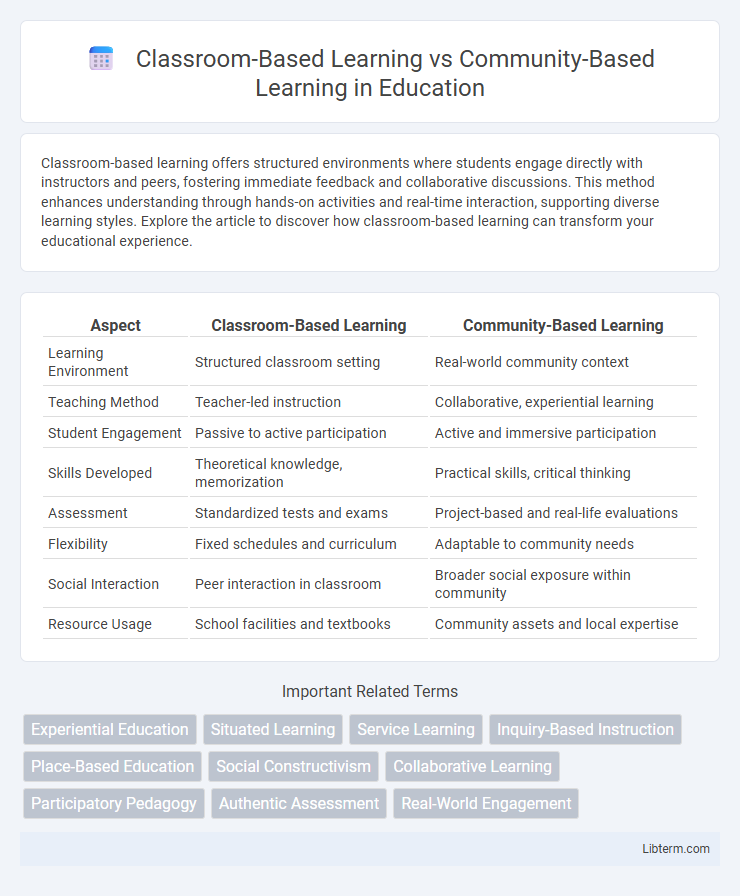Classroom-based learning offers structured environments where students engage directly with instructors and peers, fostering immediate feedback and collaborative discussions. This method enhances understanding through hands-on activities and real-time interaction, supporting diverse learning styles. Explore the article to discover how classroom-based learning can transform your educational experience.
Table of Comparison
| Aspect | Classroom-Based Learning | Community-Based Learning |
|---|---|---|
| Learning Environment | Structured classroom setting | Real-world community context |
| Teaching Method | Teacher-led instruction | Collaborative, experiential learning |
| Student Engagement | Passive to active participation | Active and immersive participation |
| Skills Developed | Theoretical knowledge, memorization | Practical skills, critical thinking |
| Assessment | Standardized tests and exams | Project-based and real-life evaluations |
| Flexibility | Fixed schedules and curriculum | Adaptable to community needs |
| Social Interaction | Peer interaction in classroom | Broader social exposure within community |
| Resource Usage | School facilities and textbooks | Community assets and local expertise |
Introduction to Learning Approaches
Classroom-based learning centers on structured, teacher-led instruction within formal educational settings, emphasizing curriculum adherence and standardized assessment. Community-based learning engages learners in experiential, real-world environments, fostering practical skills through active participation and collaboration with community members. Both approaches enhance knowledge acquisition but differ in context, interaction, and application of learning outcomes.
Defining Classroom-Based Learning
Classroom-Based Learning involves structured education within a formal setting where instructors deliver curriculum through lectures, discussions, and assessments. It emphasizes standardized content, controlled environments, and direct interaction between teachers and students. This model supports systematic knowledge acquisition and foundational skill development aligned with academic standards.
Understanding Community-Based Learning
Community-Based Learning immerses students in real-world environments outside traditional classrooms to foster practical skills and social awareness. This approach emphasizes active participation in local projects, encouraging collaboration with community members to address genuine issues. By integrating experiential learning with academic concepts, students develop a deeper understanding of societal dynamics and civic responsibility.
Key Differences Between the Two Methods
Classroom-based learning emphasizes structured instruction within a formal setting, typically guided by a teacher and standardized curriculum, fostering theoretical knowledge acquisition and skill development. Community-based learning integrates real-world experiences by engaging learners in local environments, promoting practical application and experiential understanding through interaction with community members. Key differences include the learning environment, with classroom-based focusing on controlled, academic settings, while community-based centers on active participation outside traditional classrooms, enhancing social responsibility and contextual awareness.
Advantages of Classroom-Based Learning
Classroom-Based Learning offers structured environments with direct access to instructors, enabling immediate feedback and tailored guidance that enhances student comprehension. This setting facilitates standardized curricula implementation and consistent assessment methods, ensuring uniform educational quality across different learners. Moreover, the classroom fosters social interaction among peers, promoting collaborative learning and communication skills essential for academic and professional success.
Benefits of Community-Based Learning
Community-based learning enhances practical skills and real-world problem solving by engaging students directly with local environments and social issues, fostering deeper understanding and retention of knowledge. It promotes cultural awareness, empathy, and civic responsibility through immersive experiences that complement theoretical studies. This method often leads to improved collaboration, communication, and adaptability, essential competencies in both academic and professional settings.
Challenges and Limitations of Each Approach
Classroom-based learning often faces challenges such as limited real-world application and reduced student engagement due to its structured environment and standardized curriculum. Community-based learning, while fostering practical skills and social interaction, encounters limitations including inconsistent resource availability, varying quality of mentorship, and logistical difficulties in coordinating activities. Both approaches require adaptive strategies to address these constraints and maximize educational outcomes.
Impact on Student Engagement and Outcomes
Classroom-based learning provides a structured environment that enhances student engagement through direct interaction with instructors and peers, often resulting in improved academic outcomes due to immediate feedback and standardized curriculum. Community-based learning promotes experiential education by immersing students in real-world contexts, which fosters critical thinking, social responsibility, and higher retention rates by connecting theory with practice. Both approaches impact student outcomes differently; classroom learning strengthens foundational knowledge, while community learning boosts practical skills and civic engagement.
Integrating Classroom and Community Learning
Integrating classroom-based learning with community-based learning enriches educational experiences by connecting theoretical knowledge with real-world applications, enhancing student engagement and skill development. Collaborative projects and service-learning opportunities bridge academic concepts with community challenges, promoting critical thinking and social responsibility. This holistic approach fosters deeper understanding, practical competence, and stronger community ties, preparing students for active citizenship and lifelong learning.
Choosing the Best Approach for Diverse Learners
Classroom-based learning offers structured environments ideal for delivering standardized curricula and easily measurable outcomes, making it suitable for learners who thrive in formal settings. Community-based learning provides real-world contexts and experiential opportunities that engage diverse learners through culturally relevant and practical experiences. Selecting the best approach requires assessing learners' needs, cultural backgrounds, and learning styles to create inclusive, effective educational experiences.
Classroom-Based Learning Infographic

 libterm.com
libterm.com